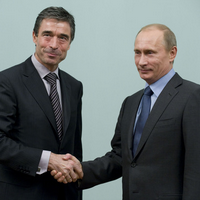During the Cold War, the U.S. installed 7,000 nuclear weapons in Europe because of the perceived military imbalance in favor of the Soviet Union. European governments, unlike their publics, accepted them with the understanding that free riding in a military alliance had its limits. But these tactical nuclear weapons, some of them much more powerful than the Hiroshima bomb, led to regular friction within NATO. Since the implosion of the USSR and the Warsaw Pact, more than 90 percent of these weapons have been withdrawn, silently and unilaterally or in a reciprocal way. Today, a total of 200 weapons remain in Germany, Belgium, the Netherlands, Italy and Turkey.
NATO defense ministers are currently gathering in Brussels to discuss the alliance's Defense and Deterrence Review, a de facto nuclear policy review. Because this issue is such a hot topic, especially between Germany and France, the overall NATO Strategic Concept deliberations in 2010 ended with a lowest-common-denominator compromise. The German government pushed for withdrawal of the weapons, while France stood at the other extreme, fearing that its "force de frappe" would be next in line. The compromise between the 28 member states more or less adopted the status-quo, emphasizing that the alliance would maintain a nuclear capability as long as nuclear weapons existed. More than before, however, the role of strategic -- as opposed to tactical -- nuclear weapons was emphasized in the Strategic Concept, and the door for possible withdrawal of tactical nuclear weapons was left open.
The most acrimonious point in the current review is not whether the last remaining U.S. nuclear weapons should be withdrawn, but when and how. Even the U.S. military agrees that the missiles' military utility is close to zero. The real question is whether or not NATO should link their withdrawal to reductions in Russia's arsenal of tactical nuclear weapons. Cold War logic would, of course, favor linkage. Another approach, however, would be to first withdraw the weapons and then start engage with Russia in negotiations over reductions in its tactical nuclear weapons as well as further reductions in strategic nuclear weapons.

